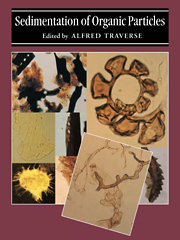Book contents
- Frontmatter
- Contents
- Editor's preface
- List of contributors
- I Introduction
- II Studies of palynosedimentation in modern environments
- III Reconstruction of late Cenozoic vegetation and sedimentary environments from palynological data
- IV Application of data on palynosedimentation to solution of geological problems
- 16 Palynology of sedimentary cycles
- 17 Particulate organic matter, maceral facies models, and applications to sequence stratigraphy
- 18 Association of palynomorphs and palynodebris with depositional environments: quantitative approaches
- 19 A quantitative approach to Triassic palynology: the Lettenkeuper of the Germanic Basin as an example
- 20 Palynomorph concentration in studies of Paleogene nonmarine depositional environments of Wyoming
- 21 Multivariate analyses of palynomorph data as a key to depositional environments of Upper Cretaceous and Paleogene coal-bearing rocks of the western United States
- 22 Relationships between depositional environments and changes in palynofloras across the K/T boundary interval
- 23 Sedimentation of palynomorphs in rocks of pre-Devonian age
- V Appendix
- Index
23 - Sedimentation of palynomorphs in rocks of pre-Devonian age
Published online by Cambridge University Press: 06 January 2010
- Frontmatter
- Contents
- Editor's preface
- List of contributors
- I Introduction
- II Studies of palynosedimentation in modern environments
- III Reconstruction of late Cenozoic vegetation and sedimentary environments from palynological data
- IV Application of data on palynosedimentation to solution of geological problems
- 16 Palynology of sedimentary cycles
- 17 Particulate organic matter, maceral facies models, and applications to sequence stratigraphy
- 18 Association of palynomorphs and palynodebris with depositional environments: quantitative approaches
- 19 A quantitative approach to Triassic palynology: the Lettenkeuper of the Germanic Basin as an example
- 20 Palynomorph concentration in studies of Paleogene nonmarine depositional environments of Wyoming
- 21 Multivariate analyses of palynomorph data as a key to depositional environments of Upper Cretaceous and Paleogene coal-bearing rocks of the western United States
- 22 Relationships between depositional environments and changes in palynofloras across the K/T boundary interval
- 23 Sedimentation of palynomorphs in rocks of pre-Devonian age
- V Appendix
- Index
Summary
Introduction
Paleopalynology is the study of microscopic structurally preserved organic matter which can be extracted from siliciclastic rocks by acid maceration. Traditionally, paleopalynology includes the study of various algal remains, microscopic parts of some protists and animals, spores of cryptogamic plants and fungi, and the pollen grains of seed-bearing plants, all of which are thought to possess a resistant organic outer wall composed of sporopollenin, chitin, or a similar derivative. This definition restricts the palynological record prior to the evolution of the terrestrial embryophytic plants to the resistant remains of algal phytoplankton, chitinous scolecodonts, and possible zooplankton such as chitinozoans. However, in this chapter I expand the view of paleopalynology to include some other structurally intact, microscopic organic remains which are thought to be of planktonic origin. This means that phytoplankton preserved in both siliciclastic (Acritarcha) and in cherty carbonate facies (Cryptarcha, sensu Diver & Peat, 1979)) is included.
In broadest terms, the study of palynomorphs as sedimentary particles concerns the distribution and dynamics of biological carbon through geologic time. The stratigraphic record of microplankton is of great importance in modeling the dynamics of former marine and terrestrial ecosystems. The changes in the flux of carbon brought about by the rise of a standing biomass in terrestrial habitats represents a fundamental shift in the distribution of biogenic carbon on the earth. This shift occurred during the Silurian Period and is marked by the fossil record of the cryptospores, which represent the palynological evidence of a transition to an embryophytedominated terrestrial ecosystem (Strother, 1991).
- Type
- Chapter
- Information
- Sedimentation of Organic Particles , pp. 489 - 502Publisher: Cambridge University PressPrint publication year: 1994
- 5
- Cited by

